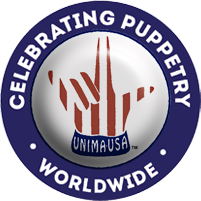
1 Wayang Tengul and Wayang Klithik
Made from wood and peacock feathers. The wood in the shape of a giant's face depicts infamy. The peacock feather symbolizes beauty, authority and kindness. Collection: Tizar Purbaya.
Photo: Reza Purbaya.

2 Wayang Suluh
Depicts of everyday life and symbols of the nation. Collection: Tizar Purbaya.
Photo: Reza Purbaya.

3 Gunungan (Betawi/Jakarta)
Depictions of Betawi Arts (ondel-ondel [red male and white female figures on bottom], kembang goyang and transport [becak/rickshaw, horse cart]). The spine becomes the white national monument [Monas] with its gold top. There is a Kala [demon head] at the top.
Collection: Tizar Purbaya.
Photo: Reza Purbaya.

4 Wayang Cirebon Kumbakarna Gugur (The Death of Kumbakarna)
Depicts the war scene between Rahwana's giant brother Kumba Karna (center, bottom) and Sri Rama's monkey troops in the Ramayana led by Hanuman the white monkey (r. bottom) and others.
Collection: Tizar Purbaya.
Photo: Reza Purbaya.

5 Wayang Cirebon Suurgaan
Depicts the heavenly environment. Collection: Tizar Purbaya.
Photo: Reza Purbaya.

6 Wayang Cirebon Isuk-Sore
Symbolizes that life is not eternal. Isuk: morning; Sore: Afternoon. Thus, life always moves forward.
Collection: Tizar Purbaya.
Photo: Reza Purbaya.

7 Wayang Menak
Depicts a gate as a path for Islamic religion teachings. Lions replace the more customary ogre figures, with two naga (serpents) center and garuda (eagles above them. The Kala head is at the top center.
Collection: Tizar Purbaya.
Photo: Reza Purbaya.

8 Wayang Wahyu
Depicts Christianity/Christian symbols such as Jesus, Angels and love between human and the environment and humans with fellow humans.
Collection: Tizar Purbaya.
Photo: Reza Purbaya.

9 Wayang Sunda
Old village-style gunungan from West Java, in the style of gunungan gapuran. Ogres at the bottom, gate flanked by garuda (eagle), facing tiger and buffalo, naga [serpent] around the trunk and a Kala head above.
Collection: Tizar Purbaya.
Photo: Reza Purbaya.

10 Wayang Golek Sunda
Gunungan and Semar. The Bandung-style Wayang Golek Sunda performance ends with the golek of Semar appearing before the kulit gunungan. The gunungan represents the cosmic order of the universe and is placed at the center of the stage before the performance commences. With the conclusion of the performance, the gunungan is again placed center stage. Although a leather shadow puppet, the gunungan fulfills its dramatic and symbolic functions not only in wayang kulit performances but also in performances using golek and klitik puppets. Dalang Dede Amung Sutarya (Bandung, West Java).
Photo: Karen Smith

11 Wayang Golek Sunda (Bandung)
Gunungan/kayon with wayang golek Gatotkaca, hero of Mahabharata. (Sanggar of Dalang Dede Amung Sutarya, Bandung, West Java).
Photo: Karen Smith

12 Wayang Banjar
Gunungan in the Wayang Banjar style and painted in the bright pastel colors favored by Dalang Sastra Wijaya. Banjar Baru, South Kalimantan, Indonesia. Sanggar Budi Seni Wayang Kulit, Dalang Sastra Wijaya.
Photo: Karen Smith

13 Wayang Parwa, Bali
The kayon (kayonan), or Tree of Life, with the Pandawa heroes of the Right to the right of the kayon, and the antiheroes of the Left to its left. Note the spotted raksasa (ogre). Sanggar Wayang Werdi Guna, Sukawati, Gianyar Regency, Bali. Dalang I Wayan Nartha, a well-known and established member of the "older generation" of Balinese Wayang Parwa dalang. At his sanggar, students from Bali and abroad study to become wayang makers, musicians, and dalang.
Photo: Karen Smith

14 Wayang Kancil
Ki Ledjar Soebroto of Yogyakarta, Central Java, with his original gunungan (the Cosmic Mountain or Tree of Life) front and back. He became attracted to Wayang Kancil later in his career. The tiny mouse deer, or kancil, is the hero of old Javanese fables adapted in Surakarta for wayang kulit performances in 1925 by Raden Mas Sayid and Bah Bo-liem. Lie Too Hien cut, perforated and painted more than 100 characters, consisting of animals of the forest. The stories of Wayang Kancil are taken from Serat Kancil Kridomartono, by Raden Panji Notoroto.
Photo: Karen Smith

15 Wayang Kulit Purwa Jawa
Dalang Ki Bambang Suwarno with gunungan (kayon). The dalang makes beautiful and very special gunungan/kayon, used as a stage prop and scene setter in both wayang kulit and wayang golek performances. This is a beautiful example of gunungan blumbangan, representing the Cosmos, characterized by a pool or pond at the foot of the Tree of Life. Here, Semar is seen meditating by the pool. Meditation (semadi) upon the nature of God and the Cosmos is the fourth essential path, or yoga, by which one may reach ultimate and eternal union with God.
Photo: Karen Smith

16A Central Javanese Style
This is a kayon that has borrowed the Ganesa (elephant) from Cirebon, though it was probably not made in Cirebon.

16B Central Javanese Style
This is a kayon that has borrowed the Ganesa (elephant) from Cirebon, though it was probably not made in Cirebon.

17 Old gunungan
Possibly a north coast (Pasisir) kayon mendung stuff.
Collection: Karen Smith
Photo: Karen Smith.

18 Old gunungan
18 Possibly from Lombok
Photo: Karen Smith

19 Central Javanese
This kayon for wayang kulit purwa with an empty center is a relatively new development and used to frame a divinity or might serve as a cave in which a hero like Arjuna does his meditation to gain a supernatural weapon in the Mahabharata.
Collection: Karen Smith;
Photo: Sam Heesen

20 Balinese
This wayang kulit parwa uses a smaller kayon with more abstract imagery.
Collection: Karen Smith;
Photo: Sam Heesen

21A Wayang Kulit Purwa Jawa, Gunungam gapuran (front view)
Puppet representing the Cosmos, with the Gates to Heaven guarded by two raksasa (ogres). Considered to be a male puppet and to date from the Kartasura period.
Collection: Karen Smith.
Photo: Sam Heesen.

21B Wayang Kulit Purwa Jawa, Gunungam gapuran (back view)
Puppet representing the Cosmos, with the Gates to Heaven guarded by two raksasa (ogres). Considered to be a male puppet and to date from the Kartasura period. Collection:
Karen Smith.
Photo: Sam Heesen.

























